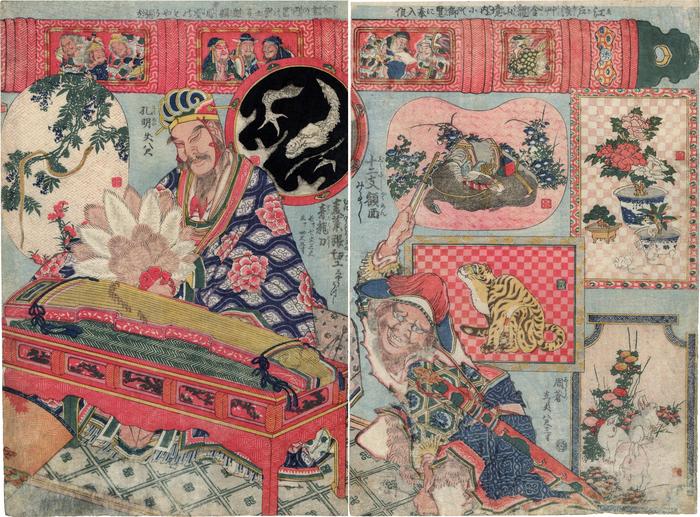Katsushika Hokusai (葛飾北斎) (artist 1760 – 1849)
A Wheat Straw Crafted Spectacle (Mugiwara hari saiku shō utsushi: 麦藁細工見世物) - the two right-hand panels of a four piece composition
03/1820
20 in x 15 in (Overall dimensions) Japanese color woodblock prints
Censor's seal: kiwame
Tokyo National Museum - links to all four panels
Tokyo National Museum (keyblock prints)
Museum of Fine Arts, Boston - far left panel of the tetraptych
Museum of Fine Arts, Boston - a different variant of these two sheets in one black and white print (a keyblock print or broadsheet)
Yale University Art Gallery - another copy of the left panel shown here
Lyon Collection - Kuniyoshi print of Kōmei controlling the wind
The right two panels from a set of four showing framed pictures of zodiac animals; working straw models; and a seiryuto (halberd) which were on view in the garden of the Kinryuzan Temple, Asakusa, Edo. The models show a Chinese woman on a white elephant with the dimensions of the figures ( eg 5 shaku 5 su’n for figure and 1 take 2 shaku for the elephant ); Emperor Komei, with measurement; the seiryuto, with measurement; and Shuso, with measurement.
This unusual composition has something to do with the Zodiac (十二支). Six of the creatures of the Zodiac are illustrated here in their own separate plaques: hares, rats, tiger, oxen, dragon and snake.
On the right-hand panel two texts appear: 1) in the right 周蒼立丈八尺三寸; 2) above, along the left hand side 十二支額面み事〳〵.
On the next panel, right by the large male figure it reads: 孔明丈八尺.
According to the curatorial notes at the Museum of Fine Arts in Boston this composition was published by Tsuruya Kiemon. The publisher's seal appears on the far left panel - not shown here. But as best we can tell it should be Tsuruya Kinosuke.
The MFA adds: "The straw-work decorations were displayed at the Kinryūzan temple in Asakusa in the second month of 1820 (Bunsei 3)."
****
Hokusai design of a sage and his attendant surrounded by Japanese artworks in representation of the signs of the zodiac. The set of four zodiac prints is exceptionally rare.
The curatorial files at Yale identify the large figure on the left panel in the Lyon Collection as "...Shokatsu Komei (Chinese: Zhuge Liang or Kongming 181-234 CE)". There is another dramatic print of Kōmei in the Lyon Collection. (See the link above.)
****
Another possible inspiration for these prints can be found in the curatorial notes from the Metropolitan Museum regarding a series of prints by Kunisada and dated to 1819. The title of those prints is Basketry Work: By the Craftsman Ichida Shōshichirō of Naniwa (Kagozaiku Naniwa saikunin Ichida Shōshichirō - 籠細工 浪花細工人 一田庄七郎).
The Met notes state: "These prints on the theme of basket subjects by Kunisada were probably designed in autumn 1819, when an exhibition of basketry was held in the Ryōgoku district of Edo (present-day Tokyo). This exhibition also included a giant figure of Shutendōji (Drunken Boy Demon), which was portrayed in a Hiroshige triptych." (JSV)
****
Illustrated:
1) in color in 原色浮世絵大百科事典 (Genshoku Ukiyoe Daihyakka Jiten), vol. 4, p. 68, #183. Only the three left-hand panels are shown here.
2) in color, the two left panels only, in 北斎美術館 (Hokusai bijutsukan or Hokusai Museum of Art), vol. 1, pp. 74-75.
3) in color in Hokusai (北斎展), Tokyo National Museum, 2005, #251, pp. 178-179.
Jūnishi (十二支 - 12 signs of the Zodiac) (genre)
Tsuruya Kinsuke (鶴屋金助) (publisher)
